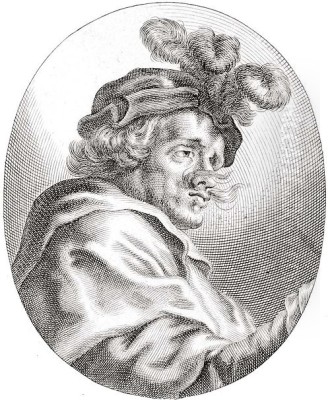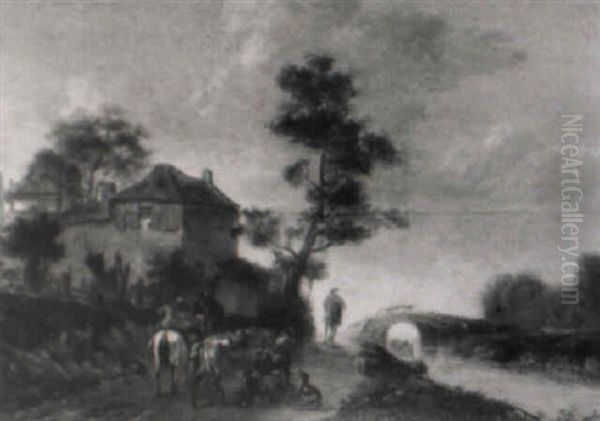Introduction: A Dutch Painter in Baroque Rome

Pieter Jacobsz. van Laer stands as a significant, albeit sometimes controversial, figure in the landscape of 17th-century European art. A Dutch painter hailing from the vibrant artistic milieu of Haarlem, he spent a crucial part of his career in Rome, becoming the fountainhead of a distinct style of genre painting. Active during the Dutch Golden Age, his work offers a fascinating counterpoint to the grand religious and historical narratives often favored in Italy. Van Laer specialized in depicting the everyday lives of ordinary people in and around Rome, scenes rendered with a characteristic realism, empathy, and often, a touch of humor. His influence was profound, establishing a new pictorial category that resonated with collectors and artists alike, both in Italy and back in Northern Europe. He is best known by his Italian nickname, "Il Bamboccio," a moniker that, while possibly referencing a physical characteristic, became synonymous with the artistic movement he inspired: the Bamboccianti.
Early Life and the Journey South
Born in Haarlem, likely baptized in December 1599, Pieter van Laer emerged from one of the primary centers of Dutch art production. While details of his early training are scarce, he would have absorbed the burgeoning Dutch tradition of realism and landscape painting. Haarlem was home to notable artists like Frans Hals and Esaias van de Velde, and the artistic environment undoubtedly shaped his formative years. Driven perhaps by the allure of Italy, the ultimate destination for ambitious Northern European artists seeking classical inspiration and patronage, Van Laer traveled south.
Around 1625, he arrived in Rome, a city teeming with international artists, ancient ruins, and the powerful influence of the Catholic Church. He was not alone; his younger brother, Roeland van Laer, also a painter, accompanied him. Another brother, Nicolaes van Laer, would later join them but tragically died young in Rome. This journey marked the beginning of a transformative period for Pieter, lasting over a decade, during which he would immerse himself in the local culture and develop his signature artistic style.
Life in Rome: Il Bamboccio and the Bentvueghels

Rome in the 1620s and 1630s was a melting pot. Van Laer quickly integrated into the community of Northern European artists residing there. He became a prominent member of the "Bentvueghels" (Dutch for "Birds of a Feather"), an informal association of mostly Dutch and Flemish artists. This confraternity served as a social network, offering mutual support and camaraderie far from home. The Bentvueghels were known for their bohemian lifestyle, boisterous initiation rituals (often involving mock baptisms with wine and the bestowal of a catchy nickname), and a general disdain for the official art establishment represented by the Accademia di San Luca.
It was within this context that Pieter van Laer received his famous nickname, "Il Bamboccio." Contemporary accounts, notably by the German painter and biographer Joachim von Sandrart (who was also a Bentvueghel member and a friend of Van Laer), suggest the name referred to Van Laer's physical appearance, possibly a disproportionate body or some form of disability. "Bamboccio" translates roughly to "ugly doll" or "puppet," perhaps seeming derogatory, yet Van Laer appears to have embraced it. His self-portraits do not shy away from a realistic depiction, suggesting a certain self-awareness. During his Roman sojourn, he is documented as sharing lodgings for a time with the Italian painter Giovanni del Campo, indicating interaction beyond the Northern European circle.
The Bamboccianti Style: Painting Roman Reality
Van Laer's artistic contribution was the popularization of a new type of genre painting focused on the everyday life of Rome's lower classes. His paintings typically depict peasants, shepherds, street vendors, artisans, beggars, soldiers, and travelers within recognizable Roman or Campagna settings – often featuring ancient ruins as picturesque backdrops. These works, usually modest in scale, captured scenes of markets, taverns, rural festivities, travelers resting, or sometimes more dramatic events like ambushes by bandits.
This style, soon dubbed "Bambocciata" after Van Laer's nickname, stood in stark contrast to the prevailing taste for large-scale history painting, mythological scenes, and idealized landscapes favored by the Italian art academies and patrons like the Barberini family. Artists like Nicolas Poussin and Claude Lorrain, also active in Rome, represented this more classical, elevated tradition. Van Laer's focus on the mundane, the unvarnished, and sometimes the coarse aspects of life was innovative and, to some, unsettling.
The Bamboccianti approach emphasized naturalism and direct observation. While often anecdotal and sometimes humorous or satirical, the depictions generally avoided overt moralizing, presenting slices of life with a degree of objectivity. Van Laer's Dutch heritage is evident in the careful attention to detail, texture, and the skillful rendering of light and atmosphere, often capturing the warm, golden light of the Italian countryside. His compositions are typically well-structured, balancing figures and landscape elements effectively.
Criticism and Acclaim
The Bamboccianti style quickly found a market among collectors who appreciated its novelty, realism, and often charming subject matter. However, it also attracted criticism from proponents of academic art theory, who adhered to the hierarchy of genres placing history painting at the apex and considering genre scenes of common life as inherently inferior. They felt such subjects lacked decorum and intellectual substance.
One notable critic was the Italian painter Salvator Rosa, himself known for his wild landscapes and battle scenes. Rosa, in his satire Pittura (Painting), disparaged the Bamboccianti for their focus on "rogues, cheats, pickpockets, bands of drunks and gluttons, scabby tobacconists, barbers, and other 'sordid' subjects." Despite such critiques from figures like Rosa and academic theorists like Giovanni Pietro Bellori, the demand for Bambocciate remained strong throughout the 17th century, indicating their appeal to a broad audience. Van Laer's works, and those of his followers, were sought after by collectors across Europe.
Key Works and Artistic Themes
Several works exemplify Pieter van Laer's style and thematic concerns. His Self-Portrait with Magic Scene (c. 1635-1637) is particularly intriguing. It depicts the artist not in the act of painting, but seemingly engaged in an occult ritual, confronting demonic apparitions. This unusual self-representation hints at an interest in the esoteric, alchemy, or perhaps simply reflects the era's fascination with the supernatural and the power of illusion, linking it metaphorically to the artist's creative power. It also showcases his ability to convey strong emotions, like fear or surprise, a skill noted by contemporaries.
More typical of his output are scenes like Attack on a Convoy or similar depictions of highway robbery (Briganti). These paintings capture the danger and chaos of travel in the period, rendered with dramatic lighting, dynamic compositions, and a keen observation of figures and animals in motion. Van Laer was particularly adept at painting animals, especially horses, which feature prominently and realistically in many of his works, influencing specialists in that genre like Philips Wouwerman back in Holland.
Other characteristic works include bustling market scenes, peasants relaxing near Roman ruins, shepherds tending their flocks in the Campagna, and gatherings outside inns. These paintings showcase his skill in creating lively, populated scenes, capturing the textures of rough-spun cloth, weathered stone, and dusty roads under the Italian sun. His use of light is often sophisticated, employing chiaroscuro to model forms and create atmospheric depth, blending his Dutch training with lessons learned from Italian masters like Caravaggio and his followers, though Van Laer's touch is generally lighter and his palette warmer.
Influence and the Spread of the Bamboccianti
Pieter van Laer's impact extended far beyond his own oeuvre. He effectively founded a school of painting in Rome. Numerous artists, both Italian and Northern European, adopted his style and subject matter. Key figures among the Bamboccianti include Michelangelo Cerquozzi, who became one of the leading practitioners after Van Laer's departure, the Flemish painters Jan Miel and Andries Both, and Dutch artists Johannes Lingelbach and Thomas Wijck. These artists continued to develop the Bambocciata genre, sometimes infusing it with their own stylistic nuances.
The influence also traveled north. Van Laer's return to the Netherlands brought his Roman experiences directly into the Dutch art scene. His work resonated with existing traditions of peasant genre painting, practiced by artists like Adriaen Brouwer and Adriaen van Ostade, perhaps encouraging a greater naturalism or introducing new compositional ideas. His depictions of Italianate landscapes with figures influenced Dutch Italianate painters like Karel Dujardin and Nicolaes Berchem, who specialized in idyllic scenes bathed in southern light.
Furthermore, Van Laer's compositions were disseminated through prints. The Dutch engraver Cornelis Visscher created engravings based on Van Laer's pastoral scenes, further spreading his motifs and style. The popularity of Bamboccianti paintings in the art market ensured that Van Laer's innovations had a lasting commercial and artistic legacy throughout the Baroque period.
Return to the Netherlands and Final Years
After more than a decade in Rome, establishing a successful career and a significant artistic following, Pieter van Laer decided to return to the Netherlands around 1639. He settled primarily in Haarlem, though he may have also spent time in Amsterdam. The reasons for his return are not entirely clear; perhaps it was homesickness, or a desire to reconnect with the Dutch art market.
His later years seem to have been marked by some difficulty. According to Joachim von Sandrart and Arnold Houbraken, another Dutch art biographer writing later, Van Laer suffered from depression. Some accounts suggest that his style, so popular in Rome, found less favor back in Holland, where tastes might have been shifting, or perhaps the direct competition with established Dutch genre painters proved challenging.
Tragically, Pieter van Laer's life came to an end in 1642. Several sources, including Sandrart, state that he died by suicide, possibly by drowning himself, in Haarlem. This somber conclusion contrasts sharply with the often lively and humorous tone of his paintings. His personal life also included family connections within the art world; one of his sisters was married to the prominent Amsterdam landscape painter Philips Koninck, linking Van Laer by marriage to another important figure of the Dutch Golden Age.
Art Historical Assessment and Legacy
Pieter van Laer occupies a unique and important place in 17th-century art history. As "Il Bamboccio," he was the catalyst for the Bamboccianti movement, introducing a vibrant strain of low-life genre painting into the Roman art scene, dominated as it was by religious and classical themes. He skillfully merged his Dutch heritage of realism and detailed observation with the light and atmosphere of Italy.
His focus on the everyday lives of ordinary people provided a fresh perspective, influencing a generation of artists in both Italy and Northern Europe. Despite contemporary criticism regarding the "lowness" of his subject matter, his works were highly sought after, demonstrating a broad appeal that transcended academic hierarchies. His technical skill, particularly in composition, the rendering of figures and animals, and the handling of light, is undeniable.
Though his career ended prematurely and tragically, Pieter van Laer's legacy endured. The term "Bambocciata" became ingrained in art historical vocabulary to describe a specific type of genre scene. He demonstrated that compelling art could be found in the streets, taverns, and fields, not just in palaces or churches. Through his innovative vision and influential style, Pieter van Laer, Il Bamboccio, carved out a distinct niche, enriching the diversity and scope of Baroque art. His work continues to engage viewers with its lively depiction of a bygone world, captured with honesty, skill, and a distinctive artistic personality.